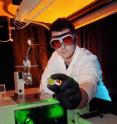Scientists study the catalytic reactions used by plants to split oxygen from water
Splitting hydrogen and oxygen from water using conventional electrolysis techniques requires considerable amounts of electrical energy. But green plants produce oxygen from water efficiently using a catalytic technique powered by sunlight -- a process that is part of photosynthesis and so effective that it is Earth's major source of oxygen. If mimicked by artificial systems, this photocatalytic process could provide abundant new supplies of oxygen and, possibly hydrogen, as a by-product of producing electricity. However, despite its importance to the survival of the planet, scientists don't fully understand the complex process plants use to harness the sun's energy.
A paper published April 2 in the journal Proceedings of the National Academy of Sciences moves scientists closer to that understanding by showing the importance of a hydrogen bonding water network in that portion of the photosynthetic machinery known as photosystem II. Using Fourier transform infrared spectroscopy (FT-IR) on photosystem II extracted from ordinary spinach, researchers at the Georgia Institute of Technology tested the idea that a network of hydrogen-bonded water molecules plays a catalytic role in the process that produces oxygen.
"By substituting ammonia, an analog of the water molecule that has a similar structure, we were able to show that the network of hydrogen-bonded water molecules is important to the catalytic process," said Bridgette Barry, a professor in Georgia Tech's School of Chemistry and Biochemistry and the Petit Institute for Bioengineering and Biosciences. "Substituting ammonia for water inhibited the activity of the photosystem and disrupted the network. The network could be reestablished by addition of a simple sugar, trehalose."
In the chloroplasts of green plants, algae and cyanobacteria, oxygen is produced by the accumulation of photo-induced oxidizing equivalents in a structure known as the oxygen-evolving complex (OEC). The OEC contains manganese and calcium ions. Illumination causes oxidation of manganese ions in the OEC. Short laser flashes can be used to step through the reaction cycle, which involves four sequential light-induced oxidation reactions. Oxygen is produced on the fourth step, and then is released from the OEC.
This so-called S state cycle resets with the binding of the substrate, water. Scientists have proposed that a hydrogen bond network, which includes multiple water molecules bound to manganese ions, calcium ions, and protein amide carbonyl (C=O) groups, forms an electrostatic network surrounding the OEC. In this scenario, the extensive hydrogen-bond network would then serve as a component of the catalyst, which splits off oxygen.
To study the process, Barry and graduate student Brandon Polander used precision FT-IR spectroscopy to describe how the network reacts to a short laser flash. The second harmonic of a pulsed Nd-Yag laser was used as the light source. This illumination causes the OEC to undergo one step in its catalytic cycle, the so-called S1 to S2 transition. An infrared spectrum was recorded before and after a laser flash to the photosystem sample, which was isolated from supermarket spinach.
The exquisite sensitivity of FT-IR spectroscopy allowed them to measure changes in the bond strength of the protein C=O groups. The energies of these C=O groups were used as markers of hydrogen bond strength. The brief laser flash oxidized a manganese ion and caused a change in the strength of the C=O bond, which reported an increase in hydrogen bonding to water molecules. When ammonia was added as an inhibitor, a decrease in C=O hydrogen bonding was observed instead. Addition of trehalose, which is known to change the ordering of water molecules at the surface of proteins, blocked this effect of ammonia.
The study describes the coordinated changes that must occur in the protein to facilitate the reaction and shows that the strength of the hydrogen-bonded network is important.
"This research helps to clarify how ammonia inhibits the photosystem, which is something that researchers have been wondering about for many years," Barry explained. "Our work suggests that ammonia can inhibit the reaction by disrupting this network of hydrogen bonds."
The research also suggests that in design of artificial devices that carry out this reaction, sustaining a similar hydrogen-bonding network may be important. The stabilizing effect of trehalose discovered by Polander and Barry may also be important.
Beyond the importance of understanding the photosynthetic process, the work could lead to new techniques for producing hydrogen and oxygen using sunlight. One possibility would be to add a biomimetic photocatalytic process to a photovoltaic system producing electricity from the sun.
"In terms of providing new sources of energy, we still have lessons to learn from plants about how they carry out these critical processes," Barry said. "It would be a great advance for the planet to have new, sustainable, and inexpensive processes to carry out this reaction."
Ultimately, she hopes the full water oxidizing cycle can be explored and potentially harnessed or imitated for oxygen and energy production.
"We are only looking at a single part of the overall reaction now, but we would like to study the entire cycle, in which oxygen is produced, to see how the interactions in the water network change and how the interactions with the protein change," Barry said. "The work is another step in understanding how plants carry out this amazing series of photosynthetic reactions."
The research was supported by the National Science Foundation.
Source: Georgia Institute of Technology Research News
Other sources
- New light shed on catalytic reactions used by plants to split oxygen from waterfrom Science DailyMon, 2 Apr 2012, 21:30:17 UTC
- Study Shows Catalyst Plants Use to Create Oxygenfrom Newswise - ScinewsMon, 2 Apr 2012, 19:30:39 UTC
- Understanding photosynthesis: How plants use catalytic reactions to split oxygen from waterfrom PhysorgMon, 2 Apr 2012, 19:00:28 UTC
